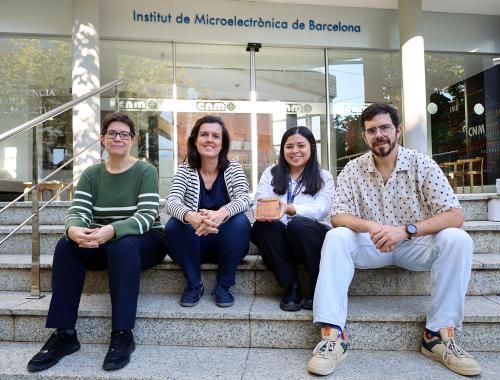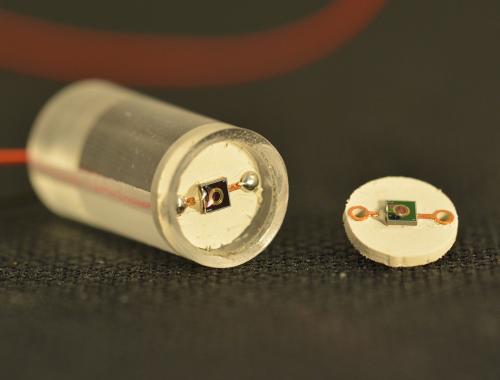Ultra-resistant radiation dosimeters designed for use in a new type of advanced radiotherapy
The system, designed and manufactured by IMB-CNM-CSIC, is more resistant and economical than conventional dosimeters for measuring doses that could be administered in the new advanced radiotherapy modality called FLASH, which is still under development. Its efficiency has already been tested in basic research particle accelerators

Main image: Preliminary assembly of the silicon carbide detector for testing. Héctor Cabezas (IMB-CNM).
A unique research project in Europe led by the Institute of Microelectronics Barcelona of the CSIC (IMB-CNM-CSIC), with the DOSIFLASH project funded by the ”la Caixa” Foundation with one million euros, is creating the world's first dose monitor to facilitate the implementation in hospitals of a new form of radiotherapy called FLASH, still in the preclinical and clinical trial phase, but considered one of the most innovative in recent years. The device is based on a new microtechnology that is ultra-resistant to extreme radiation, more accurate, and more economical than current alternatives.
FLASH radiotherapy consists of applying radiation shots with higher doses than those given in conventional radiotherapy and in fractions of a second. This considerably reduces the potential damage to healthy tissue adjacent to the treated tumor. Preclinical trials are showing that it reduces the likelihood of long-term complications in healthy tissue, one of the main problems with conventional high-dose radiotherapy. This effect has been confirmed through studies with different animal models and in various healthy organs (lungs, brain, salivary glands, intestines, skin, and bone marrow). As an additional advantage, reducing treatment time to less than 500 milliseconds reduces the uncertainties associated with organ movement, which can be very critical in the case of the lung.
Measuring doses at ultra-high rates (UHDR) poses a technological challenge because standard dosimeters, which measure the radiation given to patients, become saturated or damaged. Currently, FLASH dosimetry is mainly performed with “passive” dosimeters that require long analysis times. An alternative is to use “active” dosimeters made of diamond. However, this is very expensive.
A more efficient alternative
The IMB-CNM-CSIC has designed and manufactured new dosimeters in search of a more efficient alternative to the current diamond ones. The efficiency of the first prototype has been verified in several basic research particle accelerators in Spain, and the results have recently been published in the journal Medical Physics. A second, more advanced prototype with hundreds of dosimeters is currently being finalized and will be tested in different European clinical facilities in the coming months.
The goal of searching for new materials that are highly resistant to radiation is to develop devices that can withstand the high doses delivered by FLASH in microseconds and that are economically viable for mass production. "We propose particle microdetectors made of silicon carbide, which is a cost-effective and efficient alternative to diamond, with which it would be unfeasible to create a large dose monitor, several centimeters in size, such as the one we are currently assembling," says Consuelo Guardiola, researcher at IMB-CNM-CSIC and project leader.
Silicon carbide (SiC) is a compound of silicon and carbon that is almost as strong as diamond and much easier to obtain, although the technological development to create dosimeters has been long and complex. The use of SiC diodes for FLASH dosimetry at the IMB-CNM was initiated by scientist Celeste Fleta, a member of the team, as part of a European project (EMPIR-UHDPulse). Since then, the first experiments with particle beams have been carried out at the National Accelerator Center in Seville (CNA) and at the Curie Institute (France), in collaboration with Carmen Jiménez and Sophie Heinrich, also from the project funded by the “la Caixa” Foundation.
Further tests have been carried out at the Micro-Analysis Center for Materials in Madrid (CMAM), in collaboration with Gastón García and researchers Paula Ibáñez and Daniel Sánchez-Parcerisa from the Complutense University of Madrid (UCM). In these tests, the dosimeters “have been tested under FLASH conditions with both electrons and protons,” adds Guardiola.
IMB-CNM postdoctoral researcher Iván López, first author of the published study, also points out the success of achieving the highest doses reported to date with this material using these dosimeters. While a conventional radiotherapy session is usually around 2 Gray (Gy, energy absorbed by tissue), these dosimeters have shown a “positive response in pulses of up to 25 Gy per pulse.” In addition, he adds, “we have been able to measure the shape and distribution of the radiation beam” with a small array of these dosimeters in real time for the first time and the temporal structure of the pulses at the Curie Institute with FLASH electrons.
The next steps also include validating the functionality of hundreds of dosimeters with multi-channel electronics for each one, a task led by another consortium collaborator, Professor Faustino Gómez from the University of Santiago de Compostela (USC). In addition, a graphical interface is being developed to view dose distributions in real time with the aim of integrating this information into clinical treatment plans.
“The goal is to create the first functional and accessible real-time dose monitor as soon as possible to help implement FLASH therapy, which could improve the quality of life of patients treated with this new modality,” says Guardiola. This is in line with the commitment to transfer the unique technology developed in the IMB-CNM's Micro and Nanofabrication Clean Room to society and to create collaborative consortia, with complementary experiences, to address pressing challenges in current medical physics.
Cancer research
Cancer is the leading cause of death worldwide, according to the World Health Organization (WHO). In Spain alone, the Spanish Society of Medical Oncology reports that 286,664 cases were diagnosed in 2024. The FLASH effect has been studied intensively for a decade and is a promising response for improving treatments in the coming years.
The research is being carried out within the framework of DOSIFLASH, a project funded by the ”la Caixa” Foundation and coordinated by researcher Consuelo Guardiola. Other collaborators include the CNA, the USC, and the Institut Curie in Paris.
Two facilities with the Unique Science and Technology Infrastructure (ICTS) seal of approval from the Ministry of Science, Innovation, and Universities enable the complexity of the project to be carried out: the IMB-CNM Clean Room and the CNA accelerators.
FLASH radiotherapy
Since the first successful trial in 2019, in a patient with cutaneous lymphoma at the University Hospital of Lausanne (Switzerland), this institution has launched the LANCE clinical trial for skin cancers. In the United States, at Cincinnati Children's Hospital Medical Center (CCHMC), three clinical trials with patients have been launched since 2023 for palliative treatment of bone metastases in the extremities (FAST-01 trial). An ongoing continuation of this trial is investigating the toxicities of FLASH proton therapy in patients with thoracic bone metastases (FAST-02). Given these results, the medical and scientific communities are working together to conduct further studies that will serve as a basis for designing clinical trials with agreed-upon protocols that allow for the intercomparison of results and thus accelerate their implementation in hospitals. It is in this context that several technological challenges exist to ensure a safe and methodical transition. In particular, replicating the FLASH biological effect across institutions requires consistent and accurate dosimeters.
Image gallery
- The IMB-CNM team behind the experiments and publication. From left to right: Celeste Fleta, Consuelo Guardiola, Ángela Henao, and Iván López.
- Silicon carbide wafer processed in the IMB-CNM Clean Room with the detectors before being cut.
- Preliminary assembly of the silicon carbide detector for testing. Image: Héctor Cabezas (IMB-CNM).
- Setup of the detector at the CMAM accelerator.








